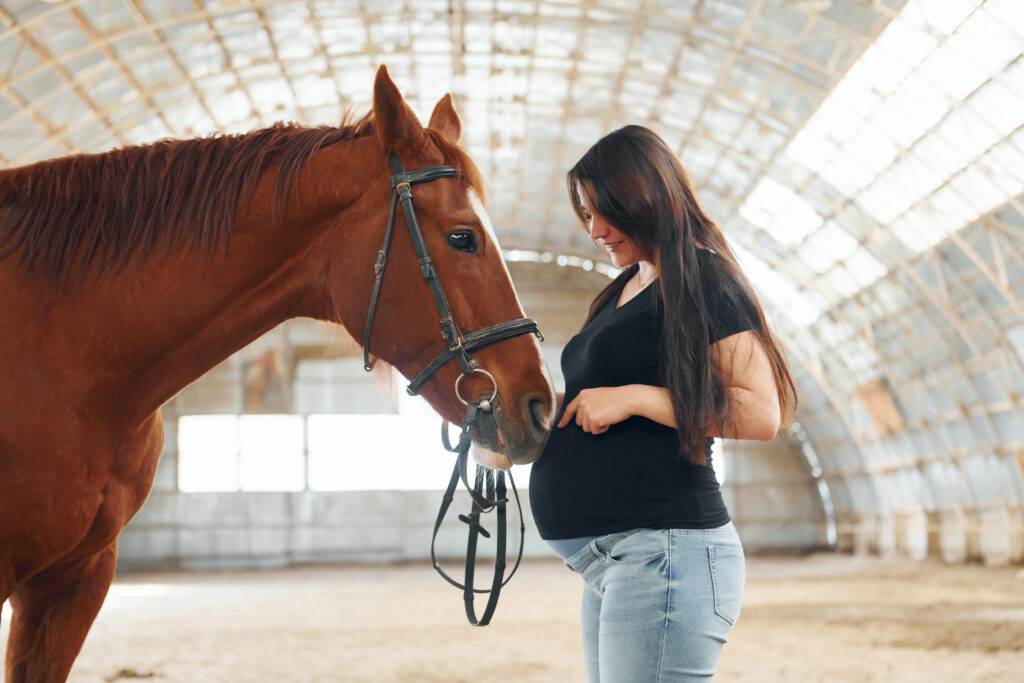
If you are or are trying to become pregnant, undoubtedly you are thinking about taking precautions for your developing child. Veterinary medicine has numerous hazards, some of which are unique to the profession and others that are common in all workplaces. Each woman is an individual, and some will have higher risk tolerances than others. Ultimately, every pregnancy is different, and flexibility and good communication go a long way in creating a smooth experience for equine practitioners.
Occupational Hazards in Equine Practice
Working in veterinary medicine increases your risks because of possible exposure to radiation, anesthetic gases, pharmaceuticals, zoonotic diseases, and viruses or bacteria. In addition, because of physical changes, personal protective equipment like coveralls and lead aprons might not fit correctly during pregnancy. A fetus might be more vulnerable to some chemicals because of its rapid growth and development, particularly early in pregnancy when its organs are developing. Changes in your metabolism also might increase how quickly you absorb substances. When pregnant, changes in your immune system, lung capacity, and balance, as well as hormonal softening of ligaments, can increase your risk of injury or illness.
Because the first trimester is the time of the most crucial fetal development, women should avoid risks as soon as possible. Therefore, it’s important to share the news of your pregnancy promptly with your employer or team so you can avoid exposure to workplace hazards. Current occupational exposure limits were set based on studies of nonpregnant adults, so what is considered safe for you might not be safe for your unborn baby.
Radiation Exposure
Radiation exposure during your entire gestation should not exceed 500 mrem. The most dangerous time for radiation exposure is following conception (preimplantation) up to the eighth week of pregnancy. Many pregnant women wear the same protective equipment while taking radiographs as they do when not pregnant, but because of changes in body shape, a wraparound lead apron might be better suited. In addition, wearing an additional dosimeter badge at the level of your uterus can provide more specific measurements of exposure to the fetus, giving you comfort as you read each monthly dosimeter report.
Drug Exposure
Some drugs prescribed for horses are dangerous for pregnant women to handle. Common examples include chloramphenicol, misoprostol, altrenogest, dinoprost tromethamine, and chemotherapeutic agents. However, these are not the only pharmaceuticals that can cause harm. Use care, read labels, and avoid handling hazardous substances as much as possible. If you do handle these drugs while pregnant, use double gloves or thicker chemotherapy gloves. Wash your hands thoroughly, and consider wearing a mask if handling tablets that could cause dust inhalation.
Waste Anesthetic Gas Exposure
Waste anesthetic gas (WAG) exposure concerns many pregnant veterinarians, but recent studies have demonstrated that rates of spontaneous abortion and low-birth-weight infants are statistically similar among female veterinarians and attorneys, suggesting WAG is being effectively scavenged in most settings. However, if you can smell anesthetic gas, the level is entirely too high for safe exposure, regardless of whether you are pregnant. Appropriate operating procedures for safe anesthesia include checking the machine for leaks before use, ensuring the scavenging system is connected and operational, and using a cuffed and properly inflated endotracheal tube. The most dangerous times for exposure are during induction and recovery, so you might want to step away at those times.
Zoonotic Infection Risk
Pregnant women are also more susceptible to certain zoonotic infections due to physiologic suppression of cell-mediated immunity. Exposure to diseases such as rabies, tetanus, C. difficile diarrhea, listeriosis, salmonellosis, cryptosporidiosis, methicillin-resistant Staphylococcus aureus infection, psittacosis, dermatophytosis, and leptospirosis have all been documented in veterinary workers. Awareness and an abundance of caution are indicated.
Injury Risk
Equine veterinarians are at risk of injury simply from the size of the animals they treat. Kicks, strikes, and crush injuries can be fatal to the fetus and/or mother. Taking your normal precautions might be inadequate, as pregnancy changes your balance and body shape. Squatting to suture a laceration might simply be impossible. Do not hesitate to use sedation, ask for help in restraining animals for treatment, and be selective about emergency calls you see.
Final Thoughts
Despite all these potential hazards, most female equine veterinarians work throughout their pregnancies with no issues. Understanding the risks, taking appropriate precautions, and asking for or accepting help when needed will likely be the only steps you need to take during your pregnancy.
Related Reading
- Parenting as an Equine Practitioner
- Veterinary Wellness Briefs: Balancing Caregiving With Equine Practice
- The Business of Practice: Balancing Parenthood With Equine Practice
Stay in the know! Sign up for EquiManagement’s FREE weekly newsletters to get the latest equine research, disease alerts, and vet practice updates delivered straight to your inbox.


![[Aggregator] Downloaded image for imported item #18375](https://s3.amazonaws.com/wp-s3-equimanagement.com/wp-content/uploads/2025/09/30140031/EDCC-Unbranded-26-scaled-1-768x512.jpeg)

